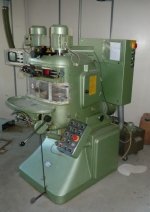Hi Cameraman,
Thanks for your response and advice. I will check out the grinding section. I guess you are right, I had a bit of luck there. Somebody at the government warned me that an auction was upcoming. Unfortunately he did not know when. So in the end, I found out only minutes before it was closing, even had to retrieve a new password 3 minutes prior in order to make a bid (it was an online auction), so it was kind of a close call. But actually I was the only one that bid on that machine. And btw on another Loh machine too, a centering machine (see picture of a similar one, mine was missing the laser and measurement unit). That one was actually only 180 Euro's so under 200 dollars. I don't think a lot of people know what to do with them.
View attachment 257818
I don't know about the new price of the Spheromatic. I guess it has been expensive but I don't think 500k. Of course it came without any of the tooling. Actually 2 of the special diamond mills cost as much as the Loh Spheromatic.
I must admit I do not use it a lot. Manufacture of optics is a bulk industry and there is so much surplus on the market, that it is seldomly viable to manufacture a lens. Especially given the amount of time you have to spend on making it. If you look at Suplus Shed for example, you can get a variety of lenses for under 5 dollars, anti-reflection coated and all...
To answer your question, I did manufacture large area telescopic mirrors in the past (up to 500mm) and I used a home made diamond radius mill for that. With these mirrors you have to remove 2kg of glass or more to get them in the right curvature before you can start grinding. Actually I stopped that activity about 4 years ago. Now I mainly do CAD design, the optics is mainly a hobby now. Cheers!






